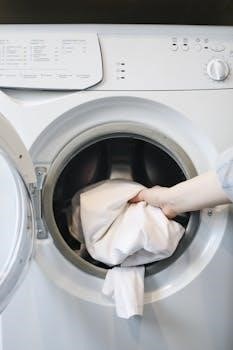Conair Fabric Steamer Manual⁚ A Comprehensive Guide
Welcome! This comprehensive guide provides detailed instructions on using your Conair fabric steamer․ It covers setup‚ operation‚ safety‚ and maintenance․ Learn how to effectively remove wrinkles and freshen fabrics‚ ensuring your garments and home textiles look their best․ This manual also includes specific model information․
Understanding Your Conair Fabric Steamer
Your Conair fabric steamer is designed for convenient and efficient wrinkle removal and fabric refreshing․ It utilizes the power of steam to gently relax fibers‚ eliminating creases without the need for an ironing board․ Different models‚ such as the GS95‚ GS59‚ GS2WB‚ GS61R‚ and GS23‚ offer varying features but share core functionalities․ Understanding the basic principles of how your steamer works is crucial for safe and optimal use․ Most models include a water reservoir‚ a heating element‚ and a nozzle for directing steam․ The steamer heats water to produce steam‚ which is then released through the nozzle․ This steam penetrates fabric‚ loosening wrinkles․ Familiarize yourself with your specific model’s manual for precise details on its design and operations․ Remember to always follow the safety instructions provided to prevent any accidents and to ensure the longevity of your device․ This section will help you understand the basic components of your steamer․
Initial Setup and Preparation
Before using your Conair fabric steamer for the first time‚ it’s important to perform the initial setup correctly․ Begin by carefully unpacking all components‚ ensuring you have the main unit‚ water reservoir‚ any attachments‚ and the instruction manual․ Read through the manual thoroughly to understand the specific features of your model‚ as they may vary slightly; Ensure the steamer is unplugged before proceeding with setup․ Place the steamer on a stable‚ level surface‚ preferably on the floor‚ as some models are designed to be used in this way․ Locate the water reservoir and familiarize yourself with how it is detached and reattached to the unit․ Make sure all parts are correctly assembled before filling the tank and plugging in the device․ This initial setup is crucial for the safe and effective operation of your steamer․ Take your time to carefully follow each step to avoid any issues during use․ Proper preparation ensures your steamer will perform optimally․
Filling the Water Reservoir
To properly fill the water reservoir of your Conair fabric steamer‚ first ensure the device is unplugged and completely cooled down․ Detach the water reservoir from the main unit‚ following the instructions provided in your manual; usually‚ this involves a simple release or twist mechanism․ Open the reservoir cap‚ and fill it with distilled water․ Using distilled water is recommended to prevent mineral buildup and extend the life of your steamer․ While some models may tolerate tap water‚ distilled water is preferable․ Be sure not to overfill the reservoir; refer to the fill line markings on the tank or in the manual․ Overfilling can cause water leakage or improper steaming․ Once filled‚ securely close the reservoir cap and reattach it to the steamer‚ ensuring it clicks or locks into place․ Avoid operating the steamer without properly filling the water reservoir‚ as this can cause damage․ After filling‚ double-check that the reservoir is securely attached before moving on to the next step․ Proper filling ensures optimal steam production․

Powering On and Steaming
After correctly filling the water reservoir‚ you’re ready to power on your Conair fabric steamer․ First‚ ensure the steamer is placed on a stable‚ flat surface․ Plug the power cord into a grounded electrical outlet․ Locate the power switch‚ often marked as “I/O” or an ON/OFF button; press it to turn the steamer on․ Some models have an indicator light that illuminates to show the device is heating․ Allow the steamer a brief warm-up period; some models heat in under two minutes․ Once heated‚ the steam button may light up red and then turn green when steam is ready․ To begin steaming‚ hold the steam nozzle near the fabric‚ keeping it a few inches away to avoid direct contact with the material․ Gently move the steamer along the fabric in a downward motion‚ letting the steam work to remove wrinkles․ For best results‚ hold the fabric taut with one hand while steaming with the other․ Avoid operating the steamer without proper water levels or if the hose and nozzle are not elevated above the water container․ The steamer is now ready to use․ Be careful‚ as the nozzle and hose will become hot during operation․
Steaming Techniques for Different Fabrics
Different fabrics react differently to steam‚ so adjusting your steaming technique is essential․ Before steaming any garment‚ always test an inconspicuous area first‚ using the lowest steam setting‚ to ensure the fabric can handle the steam’s effects․ For delicate fabrics like silk or lace‚ use a gentle‚ sweeping motion and hold the steamer slightly further away to avoid direct contact which could cause damage․ Use a light touch and avoid over-saturating the fabric․ For more robust fabrics like cotton or linen‚ you can apply the steamer closer to the material and use a slightly slower‚ more deliberate motion to effectively penetrate the fibers․ Heavier fabrics may require more passes․ Use the garment steamer’s various settings if available‚ such as dual heat‚ to accommodate different fabric weights․ Remember‚ the key is to hold the fabric taut with one hand while gliding the steamer with the other․ This technique helps the steam to penetrate the fabric‚ quickly removing wrinkles; Always ensure the fabric is well supported‚ and do not steam over buttons or embellishments․
Steaming Curtains and Drapes
Steaming curtains and drapes is an effective way to refresh them and remove wrinkles without taking them down․ Before you begin‚ ensure that your curtains and drapes are clean‚ following the care instructions for the fabric․ If they require washing‚ do so‚ and then re-hang them before steaming․ To start‚ hold the steamer a few inches away from the fabric‚ using a vertical‚ downward motion․ Work from the top to the bottom of the curtain‚ allowing the steam to penetrate the fabric․ It’s important to move slowly and steadily‚ making sure to cover the entire surface․ Pay particular attention to areas where wrinkles are most noticeable․ For thicker or heavily lined drapes‚ you may need to go over the same area a few times to relax the fibers effectively․ Keep the hose and nozzle elevated above the water container‚ avoiding any kinks or bends․ When steaming‚ hold the fabric taut with one hand‚ and the steamer with the other․ Avoid over-saturating the material‚ as too much moisture can cause damage․ Allow the fabric to dry completely after steaming․

Using the Built-in Creaser
Many Conair fabric steamers come equipped with a built-in creaser‚ which is a useful tool for creating sharp‚ defined creases in garments‚ particularly on pants‚ shirts‚ and other items that benefit from a crisp look․ Once your steamer is set up and turned on‚ according to the instructions‚ the creaser can be used to press the fabric․ To use the creaser‚ first ensure that the garment area is flat and smooth․ Position the creaser along the edge where you want to create the crease․ Apply gentle pressure to the fabric while guiding the creaser along the desired line․ The steam will help to set the crease․ It is important to use the creaser in combination with the steam function for the best results‚ as the heat and moisture will help to create a lasting‚ sharp line․ Be careful to avoid over-saturating the fabric with steam․ For best results‚ it may be necessary to make multiple passes along the crease․ Remember to always test on an inconspicuous area of the fabric first to ensure the fabric can tolerate the heat and steam․ The creaser should be used on a flat‚ stable surface․
Safety Precautions and Important Instructions

Prioritizing safety is crucial when operating your Conair fabric steamer․ Always read all instructions thoroughly before use to avoid potential hazards․ This steamer is designed for floor use; never place it on a table or countertop‚ as this could lead to instability and accidents․ Ensure the steamer is properly filled with water before operating‚ and never operate it without water in the reservoir․ Keep the hose and nozzle elevated above the water container to prevent water from flowing back․ When steaming‚ hold the fabric taut with one hand‚ and the steamer with the other‚ ensuring the steam jets are directed away from yourself and others․ Be cautious of hot steam; it can cause burns․ Always unplug the steamer from the power outlet when not in use and allow it to cool down completely‚ at least 30 minutes‚ before cleaning or storing․ Never yank the cord when unplugging․ Do not use any attachments not recommended by the manufacturer‚ as this could cause damage or injury․ It is also important to test the steamer in an inconspicuous area of the fabric first․

Decalcification and Maintenance
Maintaining your Conair fabric steamer is essential for optimal performance and longevity․ Decalcification‚ the process of removing calcium deposits‚ is a key part of this maintenance․ Over time‚ calcium buildup can occur on the metal parts of the steamer‚ particularly if tap water is used‚ affecting its steam output․ To decalcify‚ follow the instructions provided in the manual‚ which typically involves using a solution of vinegar and water․ Regular decalcification is crucial for the best performance from your steamer․ Always ensure the steamer is unplugged and completely cooled before starting any maintenance․ After each use‚ empty the water reservoir to prevent mineral buildup‚ which can contribute to blockages and reduce the steamer’s effectiveness․ Clean the exterior of the steamer with a soft‚ damp cloth and avoid using harsh chemicals or abrasive cleaners‚ as they can damage the unit․ Proper care ensures your steamer remains reliable and continues to provide efficient wrinkle removal for a long time․ Store the steamer in a cool‚ dry place when not in use․
Cleaning and Storing Your Steamer
Proper cleaning and storing of your Conair fabric steamer are vital for maintaining its performance and extending its lifespan․ Before cleaning‚ always ensure the steamer is turned off‚ unplugged from the power outlet‚ and has cooled completely for at least 30 minutes․ This prevents any risk of burns or electrical shock․ Once cooled‚ empty the water reservoir to prevent mineral buildup․ Wipe down the exterior of the steamer with a soft‚ damp cloth․ Avoid using abrasive cleaners or harsh chemicals‚ as these can damage the surface․ For the nozzle‚ use a soft brush to remove any lint or debris․ Ensure all parts are completely dry before storing․ When storing‚ choose a cool‚ dry place away from direct sunlight and extreme temperatures․ Store in an upright position‚ if possible‚ to prevent damage to the hose or internal components․ Never wrap the cord tightly around the unit‚ as this can cause damage over time․ A clean and properly stored steamer will be ready for its next use and continue to deliver optimal performance․ Following these steps will help ensure your steamer remains in excellent condition for years to come․
Troubleshooting Common Issues (No Steam)
Encountering a situation where your Conair fabric steamer isn’t producing steam can be frustrating‚ but it’s often resolvable with a few simple checks․ First‚ ensure the water reservoir is filled to the appropriate level‚ as the steamer will not operate without sufficient water․ Confirm that the unit is properly plugged into a functioning electrical outlet and that the power switch is in the ‘ON’ position․ A common issue is the unit not being primed correctly‚ especially on its first use; sometimes‚ running the unit for a little longer may help initiate steam production․ Check that the hose is not kinked or blocked‚ as this can restrict the flow of steam․ Another possible cause is mineral buildup within the steamer‚ particularly if tap water is frequently used․ Decalcification‚ as described in the maintenance section‚ may be necessary․ Ensure the nozzle is also clear of any obstructions․ If the steam button is not lighting up or turning green as expected‚ there may be an issue with the heating element․ If none of these steps solve the problem‚ it might be necessary to contact Conair customer support for further assistance‚ as there may be an internal issue that requires professional attention․ Following these steps can often get your steamer back up and running quickly․
Specific Model Information⁚ GS95‚ GS59‚ GS2WB‚ GS61R and GS23
This section details specific characteristics of several Conair fabric steamer models․ The GS95 is an upright model‚ designed for ease of use and storage‚ featuring a powerful 1500W motor to handle tough fabrics․ The GS59‚ a non-categorized model‚ has unique specifications‚ and users should consult its manual for precise details․ The GS2WB is known for its rapid heat-up time of under 2 minutes and its compatibility with tap water․ It is also safe for use on delicate materials․ The GS61R is an upright garment steamer with robust power‚ and it’s important to handle fabric taut during use․ The GS23‚ a handheld model‚ features dual heat settings; users must carefully follow safety precautions to avoid injury or electric shock․ Each model has unique features; for example‚ some have built-in creasers for precise results‚ while others focus on portability․ It is crucial to refer to the specific manual for your model to understand all its features‚ operating instructions‚ and safety advice․ These models are designed for various needs‚ from quick touch-ups to large steaming tasks‚ and understanding their differences ensures optimal use․
Conair Customer Support and Manual Access
For any questions‚ concerns‚ or assistance with your Conair fabric steamer‚ Conair provides multiple avenues for customer support․ If you need help with troubleshooting‚ understanding specific features‚ or require further guidance on using your steamer‚ contacting their support team is recommended․ Conair’s website is a key resource where you can find contact information‚ FAQs‚ and other support materials․ The Conair website also provides access to manuals for their various models․ If you’ve misplaced your physical manual‚ you can often download a PDF version from the site․ This ensures you have all the necessary information at your fingertips․ Additionally‚ Conair may offer support through phone‚ email‚ or online chat․ When reaching out to customer support‚ be sure to have your model number readily available․ This allows the support team to provide the most accurate and efficient assistance․ For specific issues like decalcification‚ proper storage‚ or identifying compatible accessories‚ refer to the product-specific manual or consult the Conair website․ Conair strives to provide comprehensive support to ensure you can fully utilize and enjoy your fabric steamer․

